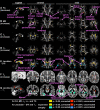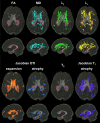Multi-modal MRI analysis with disease-specific spatial filtering: initial testing to predict mild cognitive impairment patients who convert to Alzheimer's disease
- PMID: 21904533
- PMCID: PMC3160749
- DOI: 10.3389/fneur.2011.00054
Multi-modal MRI analysis with disease-specific spatial filtering: initial testing to predict mild cognitive impairment patients who convert to Alzheimer's disease
Abstract
Background: Alterations of the gray and white matter have been identified in Alzheimer's disease (AD) by structural magnetic resonance imaging (MRI) and diffusion tensor imaging (DTI). However, whether the combination of these modalities could increase the diagnostic performance is unknown.
Methods: Participants included 19 AD patients, 22 amnestic mild cognitive impairment (aMCI) patients, and 22 cognitively normal elderly (NC). The aMCI group was further divided into an "aMCI-converter" group (converted to AD dementia within 3 years), and an "aMCI-stable" group who did not convert in this time period. A T(1)-weighted image, a T(2) map, and a DTI of each participant were normalized, and voxel-based comparisons between AD and NC groups were performed. Regions-of-interest, which defined the areas with significant differences between AD and NC, were created for each modality and named "disease-specific spatial filters" (DSF). Linear discriminant analysis was used to optimize the combination of multiple MRI measurements extracted by DSF to effectively differentiate AD from NC. The resultant DSF and the discriminant function were applied to the aMCI group to investigate the power to differentiate the aMCI-converters from the aMCI-stable patients.
Results: The multi-modal approach with AD-specific filters led to a predictive model with an area under the receiver operating characteristic curve (AUC) of 0.93, in differentiating aMCI-converters from aMCI-stable patients. This AUC was better than that of a single-contrast-based approach, such as T(1)-based morphometry or diffusion anisotropy analysis.
Conclusion: The multi-modal approach has the potential to increase the value of MRI in predicting conversion from aMCI to AD.
Keywords: Alzheimer’s disease; diffusion tensor imaging; magnetic resonance imaging; mild cognitive impairment; multi-modal disease-specific spatial filtering; pre-dementia phase; white matter.
Figures





Similar articles
-
High avidity HSV-1 antibodies correlate with absence of amnestic Mild Cognitive Impairment conversion to Alzheimer's disease.Brain Behav Immun. 2016 Nov;58:254-260. doi: 10.1016/j.bbi.2016.07.153. Epub 2016 Jul 25. Brain Behav Immun. 2016. PMID: 27470229
-
Use of diffusion tensor imaging for evaluating changes in the microstructural integrity of white matter over 3 years in patients with amnesic-type mild cognitive impairment converting to Alzheimer's disease.J Neuroimaging. 2014 Jul-Aug;24(4):343-8. doi: 10.1111/jon.12061. Epub 2013 Nov 19. J Neuroimaging. 2014. PMID: 24251793
-
Prediction of Conversion From Amnestic Mild Cognitive Impairment to Alzheimer's Disease Based on the Brain Structural Connectome.Front Neurol. 2019 Jan 10;9:1178. doi: 10.3389/fneur.2018.01178. eCollection 2018. Front Neurol. 2019. PMID: 30687226 Free PMC article.
-
Advances in longitudinal studies of amnestic mild cognitive impairment and Alzheimer's disease based on multi-modal MRI techniques.Neurosci Bull. 2014 Apr;30(2):198-206. doi: 10.1007/s12264-013-1407-y. Epub 2014 Feb 27. Neurosci Bull. 2014. PMID: 24574084 Free PMC article. Review.
-
Cerebral glucose metabolic prediction from amnestic mild cognitive impairment to Alzheimer's dementia: a meta-analysis.Transl Neurodegener. 2018 Apr 23;7:9. doi: 10.1186/s40035-018-0114-z. eCollection 2018. Transl Neurodegener. 2018. PMID: 29713467 Free PMC article. Review.
Cited by
-
Diffeomorphic Surface Registration with Atrophy Constraints.SIAM J Imaging Sci. 2016;9(3):975-1003. doi: 10.1137/15m104431x. Epub 2016 Jul 13. SIAM J Imaging Sci. 2016. PMID: 35646228 Free PMC article.
-
Pursuit of precision medicine: Systems biology approaches in Alzheimer's disease mouse models.Neurobiol Dis. 2021 Dec;161:105558. doi: 10.1016/j.nbd.2021.105558. Epub 2021 Nov 10. Neurobiol Dis. 2021. PMID: 34767943 Free PMC article. Review.
-
Multimodal Hippocampal Subfield Grading For Alzheimer's Disease Classification.Sci Rep. 2019 Sep 25;9(1):13845. doi: 10.1038/s41598-019-49970-9. Sci Rep. 2019. PMID: 31554909 Free PMC article.
-
Tensor-based morphometry using scalar and directional information of diffusion tensor MRI data (DTBM): Application to hereditary spastic paraplegia.Hum Brain Mapp. 2018 Dec;39(12):4643-4651. doi: 10.1002/hbm.24278. Epub 2018 Sep 25. Hum Brain Mapp. 2018. PMID: 30253021 Free PMC article.
-
Baby brain atlases.Neuroimage. 2019 Jan 15;185:865-880. doi: 10.1016/j.neuroimage.2018.04.003. Epub 2018 Apr 3. Neuroimage. 2019. PMID: 29625234 Free PMC article. Review.
References
-
- Albert M. S., Dekosky S. T., Dickson D., Dubois B., Feldman H. H., Fox N. C., Gamst A., Holtzman D. M., Jagust W. J., Petersen R. C., Snyder P. J., Carrillo M. C., Thies B., Phelps C. H. (2011). The diagnosis of mild cognitive impairment due to Alzheimer’s disease: recommendations from the National Institute on Aging-Alzheimer’s Association workgroups on diagnostic guidelines for Alzheimer’s disease. Alzheimers Dement. 7, 270–27910.1016/j.jalz.2011.05.774 - DOI - PMC - PubMed
Grants and funding
LinkOut - more resources
Full Text Sources


